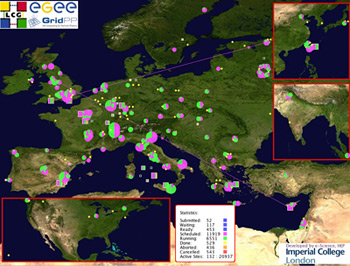 |
 |
|||||||||||||
|
|||||||||||||
|
|||||||||||||
Ever dreamt of saving computing time? "With the ILC Grid Virtual Organisation, I do in one day what I would do in about 100 days with my personal computer," said Olivier Dadoun, a post-doc at LAL, France. An important collaboration challenge for the ILC community will be to share, use and manage computing resources at a global level. The Grid computing technology offers a high capacity of computing power. You can send your job all over the world with no need for knowing where it is actually running. Scientific communities such as experiments agree on common sharing rules for resources and build Virtual Organisation (VO). Depending on which VO you belong to, you have a given amount of CPU time and disk space available in the participating computing centres to execute your jobs. There are already various Grid projects on-going in the world, from biology to the Large Hadron Collider. At the moment, the ILC Grid activities are structured in two virtual organisations, "ilc" and "calice" which ensure the specific allocation of computing resources for the ongoing ILC R&D efforts and for the CALICE (Calorimeter for the Linear Collider Experiment) collaboration test-beams (see 14 September 2006 NewsLine issue). These VOs are hosted by DESY, but many other sites support them as well, some of which already support LHC experiments. Part of the ILC software already works on the Grid. It is used for example to simulate background coming form the backscattered particles to the detector in machine-detector interface studies. Making simulations is very CPU time consuming, because in the interaction of high-energy particles with matter, lots of secondary particles are generated. To understand the origin of the background and how to reduce it, one needs to perform a full simulation of the particles. "For instance, instead of simulating tens of thousands of particles, I am able to submit via the Grid some 500 jobs containing fewer particles to different computing centres," said Dadoun, "and I obtain the results of my simulation faster." Another user of the ILC Grid, Adrian Vogel, a PhD student at DESY, has been interested in the Grid technology for one year and a half. It helps him simulate background for the Large Detector Concept (LDC) of the ILC much quicker. "I would recommend people to start using it," said Vogel. "Even though it requires some effort to learn how to submit a job at the beginning, it really pays off." Quite a few computing centres are supporting the ILC so far, mainly in Europe, and there are new ones joining regularly. More than 70 ILC scientists are using the Grid, but the community is active. Because of the ILC detectors’ high granularity, a lot of data storage and long CPU time will be needed for the project. "Since the R&D for ILC detectors and physics is accelerating rapidly, the use of the Grid within the ILC community should increase significantly in the years to come," said Dadoun. -- Perrine Royole-Degieux |
|||||||||||||
| © International Linear Collider |
